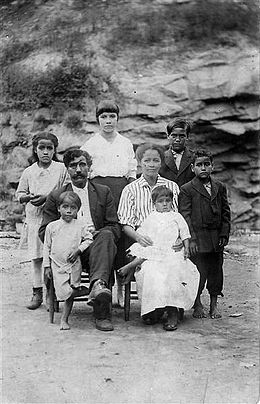
Back Melancan Azerbaijani Melungeon Welsh Melungeon German Melungeon Spanish Melungeons French Melungeon Italian Melungos Portuguese Меланджен Russian Meluncan Turkish 默伦琴人 Chinese
This article has multiple issues. Please help improve it or discuss these issues on the talk page. (Learn how and when to remove these template messages)
|
 Goins family, Melungeons from Graysville, Tennessee, c. 1920s | |
| Regions with significant populations | |
|---|---|
| United States (East Tennessee, Southwest Virginia,[1][2], North Carolina, and Kentucky[2]) | |
| Languages | |
| Southern American English | |
| Religion | |
| Protestant Christianity | |
| Related ethnic groups | |
| Lumbee, Atlantic Creole, Turks of South Carolina, Chestnut Ridge people, White Southerners, Black Southerners, Native Americans, Dominickers, Redbone (ethnicity), Mulatto |
| Part of a series on |
| African Americans |
|---|
Melungeons (/məˈlʌndʒənz/ mə-LUN-jənz) (sometimes also spelled Malungeans, Melangeans, Melungeans, Melungins[3]) are a tri-racial isolate population originating in colonial Virginia primarily descended from free people of color and white settlers.[4][5][6][7]
According to the 1894 Department of Interior Report of Indians Taxed and not Taxed within the "Tennessee" report, "The civilized (self-supporting) Indians of Tennessee, counted in the general census numbered 146 (71 males and 75 females) and are distributed as follows: Hawkins county, 31; Monroe county, 12; Polk county, 10; other counties (8 or less in each), 93. Quoting from the report:
The Melungeans or Malungeans, in Hawkins county, claim to be Cherokees of mixed blood (white, Indian, and negro), their white blood being derived, as they assert, from English and Portuguese stock. They trace their descent primarily to 2 Indians (Cherokees) known, one of them as Collins, the other as Gibson, who settled in the mountains of Tennessee, where their descendants are now to be found, about the time of the admission of that state into the Union (1796).
In the general U.S. census, Melungeon people were enumerated as of the races to which they most resembled.[8]
- ^ Cite error: The named reference
loller2was invoked but never defined (see the help page). - ^ a b Cite error: The named reference
nealwas invoked but never defined (see the help page). - ^ "1894 Report of the U.S. Department of the Interior, in its Report of Indians Taxed and Not Taxed" (PDF). www2.census.gov. Department of the Interior. Retrieved 12 June 2023.
- ^ "Melungeons | NCpedia". www.ncpedia.org. Retrieved 2024-05-23.
- ^ Schrift, Melissa (2013-04-01). "Becoming Melungeon". University of Nebraska Press: Sample Books and Chapters.
- ^ Press, The Associated Press | The Associated (2012-05-24). "DNA finds origin of Appalachia's Melungeons: African men, white women". The Denver Post. Retrieved 2024-05-23.
- ^ "Dancing Revolution: Bodies, Space, and Sound in American Cultural History 2018059613, 2019013274, 9780252051234, 9780252042393, 9780252084188". ebin.pub. 2021-07-11. Retrieved 2024-05-23.
- ^ "1894 Report of the U.S. Department of the Interior, in its Report of Indians Taxed and Not Taxed" (PDF). www2.census.gov. Department of the Interior. Retrieved 4 Sep 2023.
© MMXXIII Rich X Search. We shall prevail. All rights reserved. Rich X Search